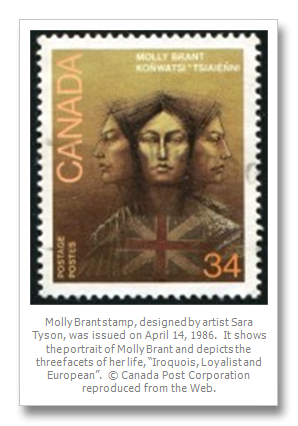I am in search of Mary “Molly” Brant, Mohawk woman of the American Revolution. Her journey once took her to Fort Haldimand on Carleton Island in the St. Lawrence River. Her historical footprints are elusive as her trail crossed the British province of New York over many miles in peace and wartime. Yet Molly was never truly of this specific colonial soil. Born in Pennsylvania in 1735, she died in Kingston, Ontario in 1795.*
Should I first seek her at Johnson Hall, Johnstown, New York, at the Georgian Mansion of Sir William Johnson? There, in 1752, she reigned as consort, wife in Indian tradition, as Lady Mary Brown. As Superintendent of Indian Affairs for the colonies, Johnson must have recognized her importance in keeping the Mohawks and Iroquois allied with England. As conflicts escalated, both Molly and brother, Joseph, must have talked about their native dilemma, as colonial military forces and settlers pressed ever westward across their land.
Johnson gave Molly social status, a home, numerous children, servants and stability. Even her Mohawk brother, educated, English speaking, Joseph, was welcomed to his residence. All this ended the day Johnson died in 1774. Molly was turned out immediately from her home, but left other lands, money and slaves. The Hall was left to John Johnson, son of William, by a previous liaison.
Taking her family and slaves, Mary relocated to Fort Niagara at the request of Major John Butler. From roughly 1778-1783 Molly was to join forces with her brother to conduct bloody battles across New York. Her advice was solicited and honored. According to Daniel Claus, British Indian agent, and Sir William’s son-in-law, “ one word from her is more taken notice of by the Five Nations than a thousand from any white man’s without exception” **
By 1783, defeats against British and Indians forced retreats to the west and north. The tribes were unable to present a united front, in spite of efforts by Joseph, now a chief of the Mohawks. Joseph was given land by England near the Bay of Quinte in Canada, and took the Mohawks there. Molly, returning from Montreal, with her family under British protection, was taken to Carleton Island in the St. Lawrence River. A home, separate from the military barracks, was provided by General Frederick Haldimand.

As more war victories favored the colonists, the border along the northern river became unsafe. Molly chose to flee to Cataraqui (presently Kingston) near Ft. Henry. The British continued to acknowledge her, provided a house, one hundred-sixteen acres, and an annual pension of one hundred pounds. In 1795* this Mohawk woman warrior died at age sixty. She was buried at St. George’s Church, today known as St. Paul’s Anglican Church. The Canadian Anglican Church also commemorates Molly Brant in their church calendar on April l6th.
Today, as I attempt to re-discover Molly’s story, I find no portrait, no grave site, (except for her children’s), and only an imagined likeness attached to a local Kingston statue. In 1986 a Canadian stamp honored her and in 1994 Canada named her a Person of National Historic Significance. Yet even her native name appears to be open to interpretation: Konwatsi’tsialenni, Degonwadonli, or Tekonwatonti.
Of all the places on which Molly set her deer-skinned or English- leathered feet, she has left behind no visible trace, at Fort Niagara, at Johnson Hall, at the ruins of Fort Haldimand or in Kingston. She remains for me as intangible and haunting as she was that day ten years ago when I first sensed her presence as we did an archeological dig at Carleton Island.
*Dates used from “Tekonwatoni/Molly Brant” by Maurice Kenny
**Wikipedia: uses birth date of 1736, Canajoharie and April 16, 1796 as date of death
By Judith F. Pearson
Judith F. Pearson is a founding member of Cape Vincent’s writer’s group, Poets & Writers INK. She became a River Rat while dating Art Pearson in 1958 as his parents had homes in Cape Vincent and a Canadian Island in the Lake Fleet. Judy, as she is known, has not missed a summer since. She is the proud mother of four and six “grands”. After moving from the island to the mainland at Cape Vincent the Pearson home, Featherbed Shoals, became a B & B for a few years. Winter months are spent in Naples, Florida. Throughout the years poetry remains a passion.